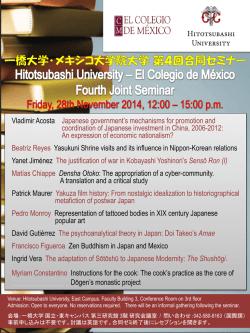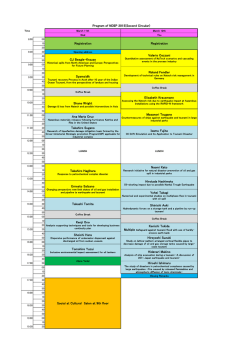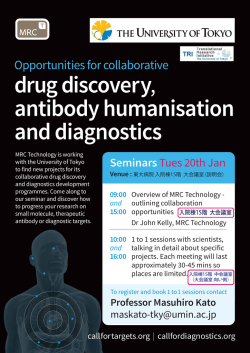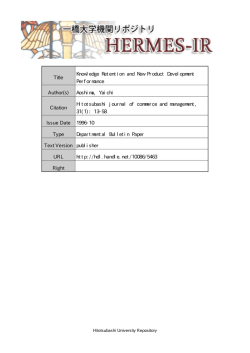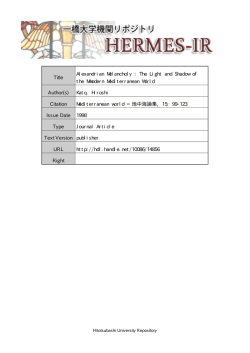
Joint Statement of 30 Disaster-Related Academic
Joint Statement of 30 Disaster-Related Academic Societies of Japan Global sharing of the findings from the Past Great Earthquake Disasters in Japan - Toward the 2015 United Nations World Conference on Disaster Risk Reduction - Toward the World Engineering Conference and Convention 2015 - November 29, 2014 Academic Society Liaison Association Corresponding to the Great East Japan Earthquake Executive Committee (members of the Committee on Civil Engineering/Architecture of Science Council of Japan) Architectural Institute of Japan Atomic Energy Society of Japan Institute of Social Safety Science Japan Association for Fire Science and Engineering Japan Concrete Institute Japan Society for Natural Disaster Science Japan Society of Engineering Geology Japan Society on Water Environment Japanese Institute of Landscape Architecture The Japan Landslide Society The Japanese Geotechnical Society The Japanese Society of Irrigation, Drainage and Rural Engineering The Society of Environmental Instrumentation Control and Automation The Society of Instrument and Control Engineers Japan Society of Material Cycles and Waste Management Association for Children’s Environment Geographic Information Systems Association of Japan Japan Association for Earthquake Engineering Japan Association for Planning and Public Management Japan Society for Disaster Information Studies Japan Society of Civil Engineers Japan Society of Erosion Control Engineering Japanese Association for Disaster Medicine The City Planning Institute of Japan The Japan Society of Mechanical Engineers The Japanese Society for Active Fault Studies The Seismological Society of Japan The Society of Heating, Air-Conditioning and Sanitary Engineers of Japan The Japan Association for Regional Economic Studies 東日本大震災の総合対応に関する学協会連絡会 (英語名と同順) 幹事会 (日本学術会議 土木工学・建築学委員会) 日本建築学会、 こども環境学会、 日本原子力学会、 地理情報システム学会、 地域安全学会、 日本地震工学会、日本火災学会、 日本計画行政学会、 日本コンクリート工学会、 日本災害情報学会、 日本自然災害学会、 土木学会、 日本応用地質学会、 砂防学会、 日本水環境学会、 日本集団災害医学会、 日本造園学会、 日本都市計画学会、 日本地すべり学会、 日本機械学会、 地盤工学会、 日本活断層学会、 農業農村工学会、 日本地震学会、 環境システム計測制御学会、 空気調和・衛生工学会、 計測自動制御学会、 日本地域経済学会、 廃棄物資源循環学会 Joint Statement of 30 Disaster-Related Academic Societies of Japan Global sharing of the findings from the Past Great Earthquake Disasters in Japan - Toward the 2015 United Nations World Conference on Disaster Risk Reduction - Toward the World Engineering Conference and Convention 2015 – The 2011 off the Pacific coast of Tohoku Earthquake (Great East Japan Earthquake) was huge and exceeded our expectations. Its induced damage was so serious that we are still recovering from it and still face many issues. Response activities undertaken against the accident of the Fukushima Dai-ichi Nuclear Power Station are very difficult and insufficient to alleviate its impact to both inland and marine environments. For many years, Japanese scientists and engineers have been trying to establish scientific knowledge and to develop technologies for disaster reduction, but they were divided into each specialty. Specialization has caused significant knowledge gaps and communication difficulties among specialties. Issues between specialties have not been tackled. There is a serious reflection that we blindly believed our scientific knowledge and technologies and we didn’t have enough sense of the awe and humble feeling to nature. After the 2011 Great East Japan Earthquake, we, 30 Japanese academic societies related to disaster management, started to deepen mutual understanding and made efforts to integrate different specialties. We also studied lessons for better recovery and preparedness from the 1995 Kobe Earthquake disaster and others. Experience and knowledge learnt from natural disasters should be widely applied to reduce all disasters worldwide. Prior to the United Nations World Conference on Disaster Risk Reduction (March, 2015 Sendai, Japan) and the World Engineering Conference and Convention 2015 (November, 2015 Kyoto, Japan), representatives from these 30 academic societies relevant to disaster management, have started to discuss ways of exchanging very rare and important experience and knowledge on such disasters. For global sharing, the representatives of 30 societies declare to promote the following actions: 1. Serious soul-searching on blind belief in our science and technologies We, Japanese scientists and engineers, have been trying to establish scientific knowledge and to develop technologies for disaster reduction and we could reduce damage by natural hazards to lower levels than before. But based on the experiences after the 2011 Great East Japan Earthquake, we seriously recognized that there was blind belief in our scientific knowledge and technologies and that they were not enough. We should always question our knowledge and never forget the sense of awe and humble feeling to nature for implementation of a disaster safe society. 2. Sharing of our experiences with international community We will contribute to disaster reduction around the world by sharing the lessons learnt from the past earthquake disasters, such as the 2011 Great East Japan Earthquake and the 1995 Kobe Earthquake disasters. We will emphasize the importance of pre-event countermeasures including damage mitigation, preparedness, disaster prediction and early warning, and warning for the possibility of unexpected huge hazards with extremely low probability. 3. Collaboration of academic societies We will collaborate across academies to promote multidisciplinary research for disaster reduction and sustainable development. The researchers in both natural and social science fields, such as physical science, engineering, medicine, sociology, and economics etc. will work together to create practical measures that have been examined from various perspectives. 4. Application to local communities We will integrate different specialties and establish comprehensive and effective risk reduction countermeasures for local communities around the world as well as in Japan, considering each local environment and condition. 5. Enhancing earth observation and strengthening international human network We will enhance the global earth observation and monitoring system, and carry out broad and integrated studies across the earth sciences, focusing on evolution and dynamics of the earth. We will pursue the cause of natural disasters and strengthen the international network of researchers and practitioners for disaster reduction. 6. Resiliency for huge hazards that exceed conventional expectations We will consider the preparedness against huge hazards, which lie beyond conventional expectations. Even if it seems to be technically impossible, we will do our best to find a way to reduce the impact due to the hazard considering environmental issues and needs for uninterrupted business and social activities during and after severe disasters. 7. Human resource development We will promote the capacity building of scientists and engineers worldwide by sharing knowledge and experiences learnt from the past earthquake disasters around the world. We will develop Japanese experts in comprehensive disaster management who can work nationally and internationally. We will also train local experts who can contribute to local disaster risk control and management. 8. Public awareness We will improve public awareness, which is one of the most important measures for disaster reduction. Pre-disaster countermeasures are effective in both human security and economic growth. We will present the knowledge based on the experiences from the past earthquake disasters in an easy-to-understand format to the public. We will promote understanding of the self-help effort, mutual assistance and public support, and will appeal their importance for disaster reduction to the public. Academic Society Liaison Association Corresponding to the Great East Japan Earthquake Executive Committee (members of the Committee on Civil Engineering/Architecture of Science Council of Japan) Steering: Akira Wada, Teruhiko Yoda, Kazuo Tamura, Masako Yoneda, Yasushi Asami and Kimiro Meguro Masanori Hamada, Shunsuke Ikeda, Mitsuru Senda, Masashi Kamon, Toshimitsu Komatsu, Haruo Hayashi, Toshihiro Iwatate, Yoshiaki Nakano, Junji Kiyono Architectural Institute of Japan President, Hiroshi Yoshino, Izuru Takewaki, Yuji Hasemi, Yasumori Maki Association for Children’s Environment President, Kimiko Kozawa, Mitsuru Senda, Yutaka Nakayama Atomic Energy Society of Japan President, Reiko Fujita, Hiroshi Miyano, Tadashi Inoue, Takanori Tanaka, Naoto Sekimura Geographic Information Systems Association of Japan President, Keiji Yano, Yasushi Asami, Wanglin Yan, Michinori Hatayama Institute of Social Safety Science President, Shigeo Tatsuki, Michio Miyano, Eiichi Itoigawa, Takaaki Kato Japan Association for Earthquake Engineering President, Susumu Yasuda, Yukio Shiba, Hajime Shinkai Japan Association for Fire Science and Engineering President, Takeyoshi Tanaka, Tokiyoshi Yamada Japan Association for Planning and Public Management President, Sukehiro Hosono, Takashi Onishi, Toshinori Nemoto, Kayoko Yamamoto Japan Concrete Institute President, Hirozo Mihashi, Toru Kawai Japan Society for Disaster Information Studies President, Akihiko Nunomura, Isao Nakamura Japan Society for Natural Disaster Science President, Kazuo Takahashi, Kimiro Meguro, Kaoru Takara, Fumihiko Imamura Japan Society of Civil Engineers President, Masahiko Isobe, Riki Honda Japan Society of Engineering Geology President, Shuichi Hasegawa, Masahiro Chigira, Yasunori Otsuka, Hisatoshi Ito, Fumiaki Nomura Japan Society of Erosion Control Engineering President, Yoshiharu Ishikawa, Masao Okamoto, Masakazu Suzuki, Hiroshi Kawabe Japan Society on Water Environment President, Akiyoshi Sakota, Hiroaki Furumai, Yoshirou Ono, Mitsuaki Ito Japanese Association for Disaster Medicine President, Yasuhiro Yamamoto, Yuichi Koido Japanese Institute of Landscape Architecture President, Akio Shimomura, Ryohei Ono The City Planning Institute of Japan President, Norihiro Nakai, Naofumi Takeuchi The Japan Landslide Society President, Satoshi Tsuchiya, Daisuke Higaki, Hirotaka Ochiai, Satoshi Goto, Hiroomi Nakazato The Japan Society of Mechanical Engineers President, Shiro Kubo, Masaki Shiratori The Japanese Geotechnical Society President, IkuoTowhata, Makoto Suzuki, Mamoru Mimura, Motoki Kazama, Jun Ohbayashi The Japanese Society for Active Fault Studies President, Atsumasa Okada, Hiroshi Une The Japanese Society of Irrigation, Drainage and Rural Engineering President, Tsugihiro Watanabe, Takeshi Kikutsuji, Akiko Kuroda The Seismological Society of Japan President, Teruyuki Kato, Kazutoshi Imanishi, Keiichi Tadokoro, Aitaro Kato The Society of Environmental Instrumentation Control and Automation President, Yoshihisa Shimizu, Kunio Waseda, Takuji Nakazato, Masaki Takaoka The Society of Heating, Air-Conditioning and Sanitary Engineers of Japan President, Takashi Inoue, Masaya Okumiya, Hiroaki Tomita, Yasuo Murata, Toshiharu Ikaga The Society of Instrument and Control Engineers President, Ryuichi Nakata, Satoshi Honda, Toshiharu Sugie, Masami Namiki The Japan Association for Regional Economic Studies President, Tomohiro Okada, Makoto Suzuki, Yoshifumi Ikejima Japan Society of Material Cycles and Waste Management President, Toshihiko Matsuto, Toshiaki Yoshioka, Yuichi Moriguchi Cooperation: Muneyoshi Numada, Hiroki Kobayashi ‘Academic Society Liaison Association Corresponding to the Great East Japan Earthquake’ The members of Science Council of Japan become founders and 30 academic societies relevant to disaster management gathered since the 2011 Great East Japan Earthquake occurred. This Association and Science Council of Japan held 10 serial symposiums of ‘How to protect people’s lives and national land from huge hazards’. This Association aims to collaborate across academies and deepen mutual understanding, and discuss the direction of future beyond different expertise. This activity is supported by the Interdisciplinary sub-committee set up under the Committee on Civil Engineering / Architecture of Science Council of Japan. Homepage: http://jeqnet.org/sympo/index.html Contact to: [email protected] (secretariat)
© Copyright 2025
